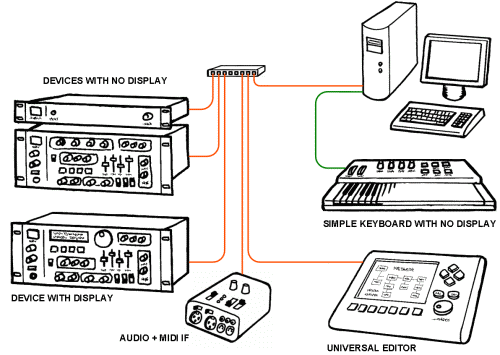New concepts in product design
- Flexible architecture
- Split Device Concept
- Blind Box
- Digital Rights Management
Linking in total freedom
Many complex products are made of a number of prearranged functional blocks that can only be rearranged in a limited way.
CopperLan's fused approach allows every source and target of information to access any other, not only inside the box, but allover the network, including virtual devices running on a computer.
Such interaction capability is the core of CopperLan's implementation, allowing the most exotic configurations to work in either direction and with no restrictions at all.In the MI domain, building on such flexibility, the system allows replication of the free patching capabilities found in earlier modular synthesizers.
Dedicated controls and modulations to numerous functions can be neatly organized according to a matrix and are accessible by name as well as their target devices.
One for all, all for one
Modern products are typically made of functional building blocks whose selection, sizing and combination are often following marketing concepts.
CopperLan brings an innovative approach to splitting products into several units, either partly or totally. This allows easy modular and universal communication and interaction as well as implementing manufacturer dependent features. All units seamlessly interact as if they were in the same casing.
A few ideas for split products...
- A mixing desk control surface could be acquired in slices of x strips each, but globally acting as a single box unified product.
- Complex products such as arranger keyboards could be offered as separate blocks (arranger, sequencer, keyboard, panel,...)
- There could be a choice of different displays for a given controller, and more than one could be fitted... at various places.
- A computer screen could offer simultaneous multiple display services to a number of hardware devices that lack display capability.
- A full editing front panel would interact as if fitted locally
- Various storage units could be optional add-ons
Reducing the cost, not the capabilities
Some devices if they were built, would present settings rarely accessed, if not just once at setup time.
Too often, the cost of implementing a display or a set of buttons for such rarely accessed functions is precluding the commercial existence of the device itself.As CopperLan guarantees that all parameters can be made accessible in a universal way, it becomes possible to design devices that rely partly or mostly on other devices capabilities.
This opens the door to a huge potential of innovative product design.
A product does not need to contain all of its editing and displaying human interface elements to exist anymore.
We can think of a few interesting examples:
- A rack-mounted sound processor whose display is actually on the floor pedal, or the reverse.
- A master keyboard that can have its parameters set on a computer screen or accessed by the standard editing buttons of any sound module.
- Any given device that usually sells in several units per setup can exist in knobs-fitted and panel-blind versions, the first kind taking control of the second one as if it was part of it, including the full visual feedback.
-
A further product concept is about having a given front panel taking full control of a dissimilar device.
The interrogation and self-adjusting mechanism involved takes care of identifying which elements are strictly identical in their role on both machines so that a real one-to-one operation is possible; then the non-matching elements can be assigned to a so called "universal" controller area.
It is even possible to retrieve the labels of the parameters now assigned to "neutral" physical controllers in order to display their use alongside the relevant knob or slider.
Protecting your business
By the time an entire setup becomes more of a unified symbiotic piece of equipment than the juxtaposition of unrelated bits of functionality, innovative concepts can emerge.
In contrast with the current way of protecting software with hardware keys, it makes more sense to share the role and job among multiple sub-systems, where the security resides in the repartition of the processing itself.
Decentralizing the application is also an efficient way of realizing a task closer to the source or destination of the data.
Application code could be sent remotely in an encrypted format only usable by the target device.
Such remote device could possibly become the handler of a DRM scheme offering its services for matching devices in the system.
